Contents
Radish “Celeste F1” is a well-known hybrid of ultra-early ripening, bred by Dutch breeders in order to obtain early production. These beautiful bright scarlet root crops can be found on sale all year round, as the variety grows well not only in summer cottages, but also in greenhouses, where it is often grown for sale. Thanks to its excellent taste characteristics, it has become very popular in private gardening and farms. Agrotechnics of cultivation and a description of the variety of radish “Celesta” will be presented below in the article.
Features of the variety
Radish of this variety is considered one of the best among the Dutch selection. It is recommended by specialists for growing an ultra-early product in open ground, as well as for year-round harvesting in greenhouse conditions. When breeding a hybrid, breeders made sure that, along with a very early ripening period, it combines all the necessary qualities and characteristics: high yield, good adaptation to growing conditions and diseases, beautiful presentation and excellent soft taste.
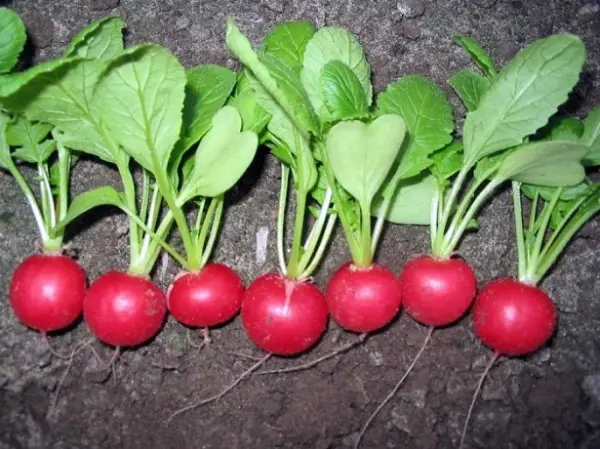
With proper care, the variety gives high yields, both in greenhouses and in open ground. Radish has a beautiful appearance: it has a rounded shape, a smooth, even surface, completely painted in an intense scarlet color. The pulp of root vegetables is white, very juicy, crispy, dense, slightly spicy taste. The size of root crops is 3–5 cm in diameter with a weight of 25–35 g. Despite its juiciness, radishes can be stored for a long time without loss of taste and are well transported.
Advantages and disadvantages
Describing the Celeste variety of radish, it can be noted that it has practically no drawbacks, but there is a whole list of advantages:
- has a short growing season (the first crop can be harvested 3 weeks after sowing);
- characterized by high germination and friendly ripening of root crops;
- grows equally well in open ground and greenhouses;
- easily adapts to changing conditions;
- does not need a long daylight – grows well in greenhouses in winter;
- resistant to diseases, does not form arrows and peduncles;
- has excellent taste and external characteristics;
- root crops are stored for a long time and are well transported.
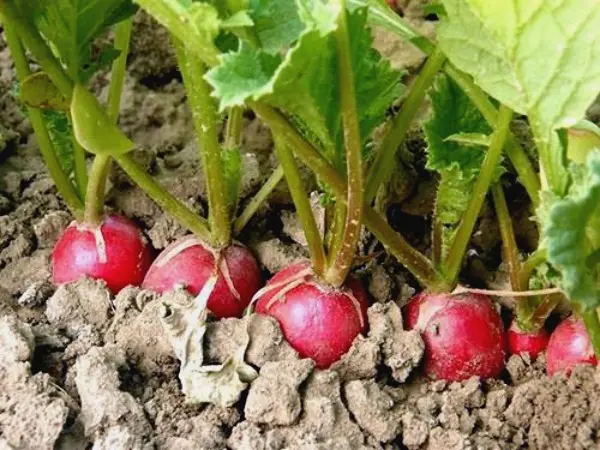
Terms and technology of sowing
In a heated greenhouse, you can grow radishes all year round. However, the biological characteristics of the culture are such that seeds germinate best in early spring, in March – April. Root crops of this variety ripen in 25–35 days, but depending on the time of planting and growing conditions, the timing may be different. If the seeds are sown in early February, then it will take about 1,5 months to ripen, if in March, the period will be reduced to 1 month, and radishes sown in April ripen in greenhouse conditions in 21–25 days.
If the purpose of growing radishes is the autumn or winter consumption of vegetables, then it must be borne in mind that from September to January, root crops grow less intensively than in spring – it may take 1,5–2 months to ripen one crop.
To keep fresh vegetables on your table regularly throughout the winter, seeds should be planted every 2 weeks.

Sowing radishes in a greenhouse should begin with soil preparation. Radish variety “Celesta” prefers loose and fertile soil, it is better if it is a light sandy loamy substrate with neutral acidity. If the soil in your greenhouse is far from these characteristics, you need to adjust its composition: river sand will help make the soil looser, and lime or dolomite flour should be added to equalize acidity. Then you need to dig up the bed, add mineral fertilizers, level it, and leave it for a while to warm up.
The area where radishes will be grown should be well lit naturally, even if your greenhouse has plant lights. Before planting seeds, the bed should warm up. Crop rotation should also be observed – do not plant radishes after cruciferous crops (all types of cabbage, radish, turnip). It is not recommended to sow seeds for 2 years in one place – this can affect the yield.
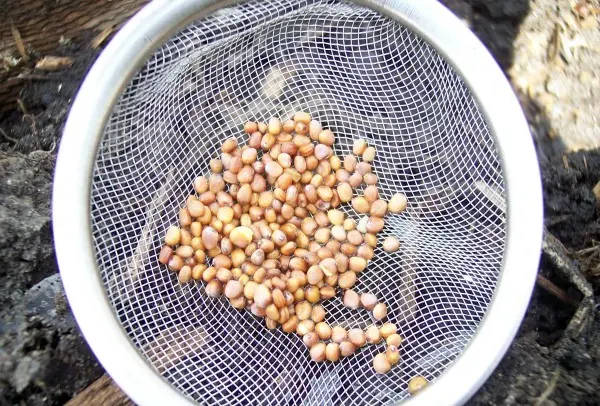
Seeds before sowing also need to be prepared. First of all, they need to be calibrated (choose the largest ones). The larger the seeds, the better and faster they will develop. After selection, the seed must be soaked in water. Heavy, which means high-quality seeds will settle to the bottom, and empty ones will float. For sowing, we take only those that have sunk to the bottom and disinfect them in a solution of potassium permanganate for about 1 hour. For speedy germination, the material can be soaked for a day in warm water, or wrapped in a wet cloth.
When the soil and seed are prepared, you can start sowing. Along the entire length of the beds, furrows should be made 3-4 cm deep at a distance of 6-10 cm, water them well. Then place the seeds in the holes at a distance of 4-5 cm, preferably in a checkerboard pattern. You can, of course, sow thicker and in one row, but then the seedlings will have to be thinned out. The depth of seed placement should not exceed 1,5 cm. After sowing, the furrows are carefully covered with earth and leveled. The first shoots, as a rule, appear after 2-3 days.
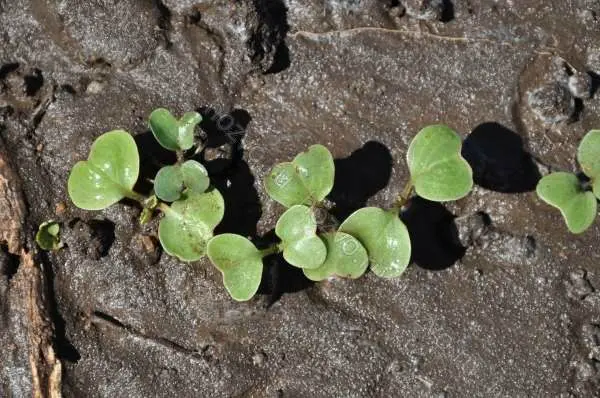
Care
The main care for Celeste radish in greenhouse conditions is regular watering and maintaining the required temperature. Water the bed with a little warm water 2-3 times a week. It is necessary to ensure that the soil moisture at a depth of 7–8 cm is always at the same level (approximately 80%). Radish loves moist soil, but does not tolerate stagnant moisture. If the plants are flooded, then the roots will crack. The same thing will happen with abundant watering of parched soil. So that the earth does not dry out, the bed can be mulched with a thin layer of peat.
Growing radishes in a greenhouse requires compliance with the temperature regime. Radishes grow well at low (+2 °C) temperatures, but in a greenhouse, as a rule, the degree is much higher. Before germination, a temperature of + 10-15 ° C is considered acceptable. Such conditions provide rapid seedlings. After the emergence of sprouts, the temperature must be reduced to + 8–10 ° C, since a higher degree will lead to stretching of the plants. After the formation of several true leaves, the temperature is raised again to + 16–20 ° C – this is necessary for the formation of root crops. In the future, you need to ensure that the temperature does not exceed + 20–22 ° C, and periodically ventilate the greenhouse.
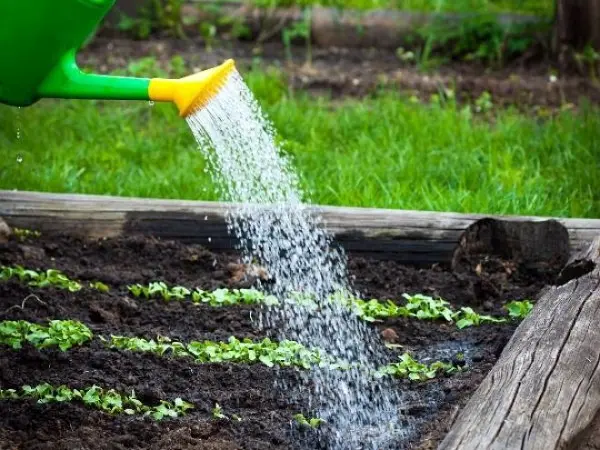
If the root crops are quickly formed and have a good presentation, then fertilizers can not be applied, but if the radish is small and grows for a long time, then it needs to be fed.
In a small amount, liquid mullein, a solution of ash can be introduced into the soil. It is not necessary to apply mineral fertilizers at this stage, since radish quickly accumulates harmful substances, in particular nitrates.
Dig up radishes of this variety when the root crops reach a size of 2–3 cm in diameter. The crop is harvested as it grows, every 7-10 days. The average yield of a variety from 1 sq. m. averages 2,5–3,5 kg. In the middle of the harvest, new seeds can be sown between the rows – this saves the area of the greenhouse and accelerates the process of maturation of the new crop.
Video “How to grow radish Celeste”
In this video, an expert from the agricultural company “Partner” tells how to grow a fast-growing hybrid “Celesta F1”.









